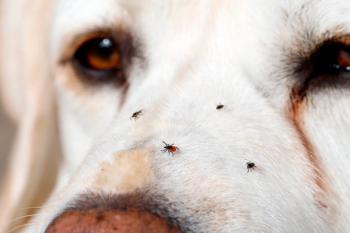
Can that lawn service replace the use of flea and tick preventives?
Companies heavily advertise their flea- and tick-repelling sprays this time of year. Are your clients buying the hype?
Shutterstock.com
When it comes to flea, tick and external parasite prevention, the old real estate saying rings true: It's all about location, location, location. Some lawn companies are advertising area treatments for yards that purport to eliminate the need for external parasite prevention for pets. Let's take a closer look and see if we like the location, location, location! Here are client communication tips to use when your clients refuse preventive medications in favor of yard treatments.
Where are the parasites located?
As you know from all those thorough dissections of parasite life cycles, adult fleas and most mites need to be located on pets and not in the yard. Make sure your clients know that just like the idea of bug bombing a house instead of treating a dog won't work, applying insecticides to the lawn won't treat a pet for fleas and mites. Ticks prefer tall grass and brush, leaf litter and bushes at the height of their hosts. Spreading things on the lawn isn't applying them higher up or in deeper brush where the ticks live. Verdict: Location No. 1 isn't looking so good.
Where is the pet located?
If a pet never sets foot outside a perfectly manicured and treated lawn and your client has put up a magical barrier that prevents other animals from coming into the yard, then yard treatments are probably perfectly appropriate for that client (just like pigs fly …). However, if the pet is ever located somewhere else besides the yard (ahem, all dogs) then your client needs prevention that moves with the pet and isn't fixed to the lawn. Remind your clients that other animals also come into the yard and bring more parasites with them. A thought experiment for clients: Think about those rascally squirrels your dog has to keep chasing out of the yard. Chances are some of them are covered with fleas or ticks-or both-that are continuously seeding the yard (and heaven forbid if the dog actually catches one). Verdict: Location No. 2 could definitely use some work.
What are your clients putting on the yard?
Ever wonder what these products used to treat the yard have in them? Well, looking at many advertisements, it's difficult to tell. All the flowery promises lead to no specifics other than vague mentions of proprietary blends of chemicals. Tell clients that if they are counting on them to be effective and not toxic to pets or people, they should be able to look at what it is and what, if any, the possible side effects are. With topical or systemic medications applied to a pet, clients should be able to read all the ingredients and pertinent information on the drug label that comes with each box. Verdict: If you can't find location No. 3, why are you using the product?
Newsletter
From exam room tips to practice management insights, get trusted veterinary news delivered straight to your inbox—subscribe to dvm360.






